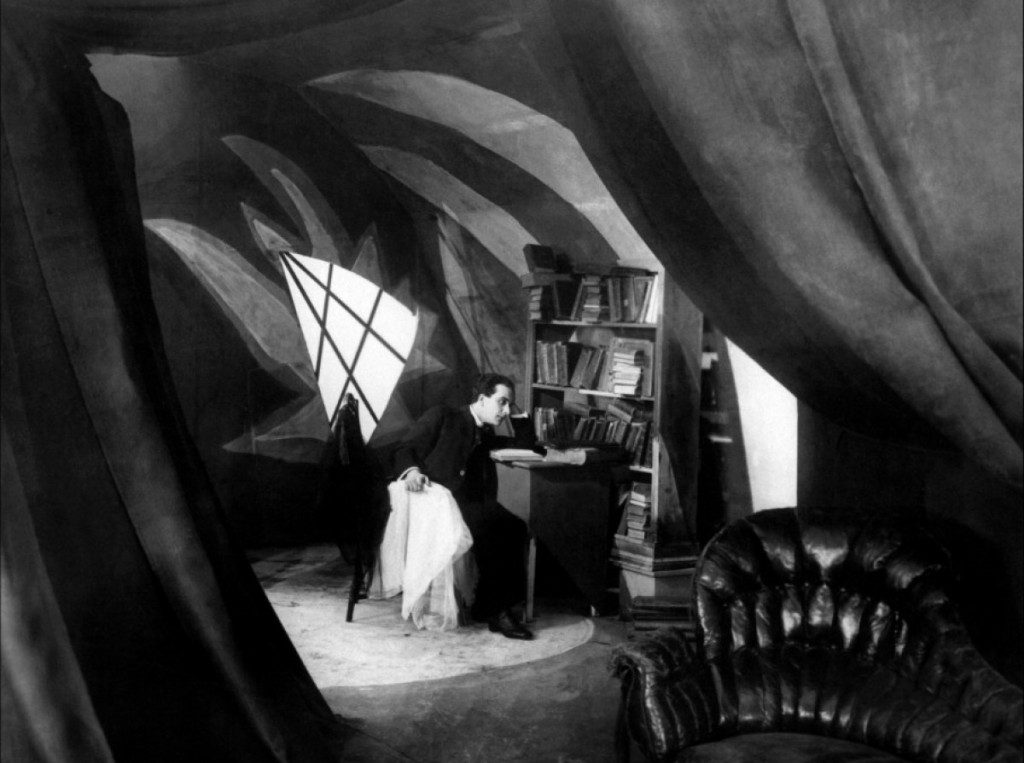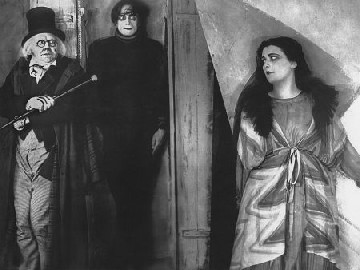
Halloween is almost here, so let’s stick with the scary again this week. Film buffs are one of the few groups of people who have extremely positive associations with the words “Weimar Republic”. The German film industry had an embarrassment of talent and explosive creativity in the 1920s. This week’s film recommendation is one of a number of innovative German movies of the era that profoundly influenced whole swaths of 20th century film worldwide: The Cabinet of Dr. Caligari.
It’s a story within a story, told by a man named Francis (Friedrich Fehér) after he sees “his betrothed” walk by in a daze. They have shared an amazing experience he says, and then the film transitions to his bizarre tale of a carnival sideshow that features a fortune-telling somnambulist. The sideshow is operated by the mysterious Dr. Caligari (a magnetic Werner Krauss) who seems to have control over the sleepwalker Cesare (Conrad Veidt). The creepy Cesare blandly informs a carnival patron that he will die at dawn, and the prediction comes true! It’s one of a series of murders that have been terrorizing the countryside. But who is the killer, and what will happen to the fetching damsel in distress (Lil Dagover) whom Francis and his friendly rival Alan (Hans Heinrich von Twardowski) are trying to woo? Strap yourself in for cinema’s first horror film AND the first film with a twist ending (and what a twist!).
 Made by Robert Wiene in 1919 or 1920 (depending on which film guide you believe), The Cabinet of Dr. Caligari remains one of the most visually striking films in history. Expressionist artists Hermann Warm, Walter Röhrig and Walter Reimann produced a set design to die for, with light and shadows physically painted onto the walls and floors, twisted furnishings, canted windows and doors, and chiaroscuro galore. It’s a madman’s dreamscape, a physical expression of a warped psychology. Many of the actors move in a stylized way (Caligari recalls a scuttling spider, Cesare a cross between a mod dancer and the Frankenstein monster), further heightening the atmosphere of unreality. And it all would have looked even more mesmerizing at the time because the film was tinted rather than being in pure black and white.
Made by Robert Wiene in 1919 or 1920 (depending on which film guide you believe), The Cabinet of Dr. Caligari remains one of the most visually striking films in history. Expressionist artists Hermann Warm, Walter Röhrig and Walter Reimann produced a set design to die for, with light and shadows physically painted onto the walls and floors, twisted furnishings, canted windows and doors, and chiaroscuro galore. It’s a madman’s dreamscape, a physical expression of a warped psychology. Many of the actors move in a stylized way (Caligari recalls a scuttling spider, Cesare a cross between a mod dancer and the Frankenstein monster), further heightening the atmosphere of unreality. And it all would have looked even more mesmerizing at the time because the film was tinted rather than being in pure black and white.
Like the best art of this type, the unreality expresses a greater reality. Continue reading “Weekend Film Recommendation: The Cabinet of Dr. Caligari”